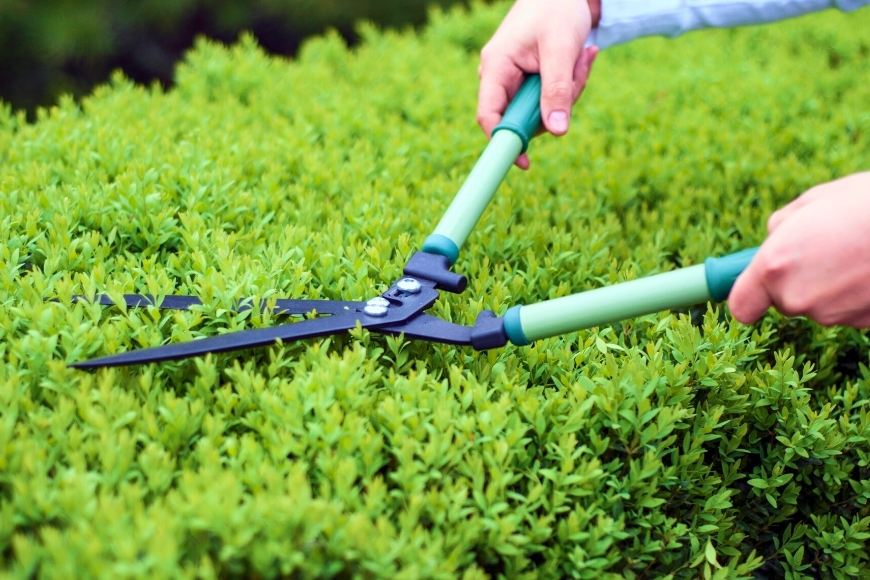
Summer is in full swing--which means that all of your plants are growing like weeds. Your weeds are also probably growing like weeds, too--but that’s for another article.
With so much growth, you’ve likely noticed your hedges looking a little unkempt, even scraggly. While this rapid growth can look messy, it also makes summer the ideal time to reshape your hedges and perform major pruning.
So, how can you help your hedges shape up? With a good trimming. So, get ready to give your hedges, shrubs, and small trees a healthy trim.
Here are our top 5 tips for keeping your hedges healthy and looking their best with a trim:
Visualize the End Result Before You Begin
Whether your hedges already have an established shape or you’re starting from scratch, you will want to decide what you want before you begin snipping away foliage and branches.
Decide on the height and general shape. You can aim for a squarer appearance, more rounded, an umbrella form, or conical shape. Keep in mind that your shrubs and hedges should always be wider at the base than the top and account for summer regrowth in your plan.
Know Your Hedge Trimming Tools
When it comes to keeping your hedges gleaming and tidy, you will want to use both hand tools and a power hedge trimmer. Your hand tools will allow you to lop off larger branches and give you greater control as you prep your hedges and after you use your power trimmer.
To keep your hedges looking their best, you will want to invest in:
- A hedge trimmer: gas or electric, along with safety glasses, gloves, ear protection, closed-toe shoes, pants, and a long-sleeve shirt. Your hedge trimmer works best for shaping and evening out the foliage.
- Hedge shears: Use your hedge shears for areas your hedge trimmer cannot be safely used.
- Loppers: Loppers work wonders on larger, old-growth branches that are growing in a direction that is contradictory to the shape you’re trying to achieve. They also allow you to thin your bushes and hedges before trimming them.
- Pruning shears: While pruning shears are likely to be the least used as you trim your hedges, they allow you to snip thinner branches that are more difficult to reach.
Hedge trimmers can be inconspicuously dangerous. They’re lightweight and easy to use, which makes them highly maneuverable, but this also makes injury more likely. When using your hedge trimmer, be sure you take all necessary safety precautions.
If you have not used a trimmer before, practice holding the trimmer and throttling the power-control handle before running it through a shrub.
Before beginning the job of trimming your hedges, be sure to hydrate well. When using your trimmers, always keep both hands on the trimmer, and use wide sweeping motions.
For taller hedges, never stand on a step ladder or ladder that is not stable. And if you’re using an electric trimmer, be vigilant of where your cord is at all times.
Prune & Trim Strategically
When you trim your hedges, you’re removing the newest growth (terminal growth). This is fine to do in moderation, but you do not want to trim off new growth more than once per season.
Shaving off new growth too often not only starves your plant of much-needed sugars but can also result in leggier regrowth and shallower roots. Shearing your shrubs too often can also encourage pests and disease.
Instead, spend some time examining the interior of your bushes and hedges to select unhealthy branches that aren’t quite pulling their weight. Examining your shrubs beneath the exterior foliage also gives you the opportunity to check for active bird nests (and wasp nests).
Bottoms-Up & Begin with Bigger Branches
It’s easy to grab your power trimmer and begin shaping your shrubs right away. However, this isn’t the healthiest choice nor is it the most efficient.
For healthy trimming follow these steps:
- After identifying unhealthy branches, trace the branch to where it transitions from unhealthy to green, strong wood. At that point, follow the branch back beyond this point and make a cut with your loppers on a 45- to a 90-degree angle.
- For branches that are mostly damaged wood or crossing over other branches, cut them back as close as possible to the main trunk.
- For non-privacy hedges, remove any branches that come in contact with neighboring shrubs. Be sure to account for regrowth.
- After pruning back larger branches, use your trimmers beginning at the base of your hedges and moving upward.
- Do not aim for absolute perfection with your power trimmer. Instead, use your other tools to refine the shape afterward.
- Always disinfect your shears and other tools between shrubs to prevent the spread of disease.
Not All Shrubs Can Be Sheared
While power trimmers make quick work of keeping your hedges toned and more formal in appearance, not all shrubs and bushes can handle a power trim. Any shrubs with large leaves will likely suffer from sunburn and dieback if trimmed with an undiscerning eye. Other species will lose their character if overly shaped.
Can be sheared:
- Yews
- Hollies
- Barberry
- Burning bush
- Boxwoods
- Fir
- Juniper
- Privet
Must be hand-trimmed:
- Gardenia
- Crape myrtle
- Forsythia
- Viburnum
- Spirea
- Roses
- Weigela
Hand-pruned or sheared (before July), depending on the desired shape:
- Azalea
- Camelia
As you whip your shrubs into shape this summer, keep in mind that all gardening is a process. You’re better off leaving more foliage rather than less and waiting until next year to revise your shrubs’ forms.
With a bit of planning, practice, and know-how, your hedges will remain healthy, strong, and attractive. So, proceed with safety and strategy and your shrubs will soon return to a glowing and glorious state of beauty.
Happy planting!
